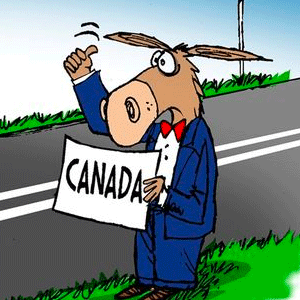What You Didn't Hear About on Election Night: The Other 43 States
Here are some observations on what you didn't hear on election night. Most networks' focus was, quite properly, on whether former President Donald Trump or Vice President Kamala Harris would carry enough of the 93 electoral votes of the seven target states -- Arizona, Georgia, Michigan, Nevada, North Carolina, Pennsylvania and Wisconsin -- to win the needed 270 electoral votes. Public polling, as reported and analyzed by websites such as RealClearPolitics and Silver Bulletin, had Trump ahead in most of the target states, but by microscopic percentages, and polling in both the 2016 and 2020 cycles had understated the percentages Trump ended up winning.
Once it became clear that Trump was not going to lose Iowa, despite Ann Selzer's Des Moines Register poll, and that Harris was not going to lose New Hampshire, despite one odd poll showing the opposite, the focus remained on the seven target states, none of which got called by the networks, the Associated Press or The New York Times until the wee hours after midnight.
As of Thursday afternoon, Georgia, North Carolina, Pennsylvania, Wisconsin and Michigan have been called for Trump, and he is leading in Arizona and Nevada; with 69% and 90% of votes counted, respectively, Trump's lead in both states -- 3.8% in Nevada, 5.5% in Arizona -- seem likely to hold up. It looks very much like he will carry all target states and win the election with 312 electoral votes, eight more than he won in 2016 and six more than President Joe Biden won in 2020, when Trump lost six of the seven states, carrying only North Carolina.
One thing that's interesting here is that Trump's percentage did not increase much in most of these states, even though he appears this time to have won the popular vote. His current popular vote lead of 50.9% to 47.6% is likely to be reduced as votes still come in from Western states, especially California, which has about 8 million votes uncounted. However, even taking into account the likely reduction of that percentage, percentage gains in target states are mostly or all below average: only 1.2% in North Carolina, 1.5% in Georgia, 1.7% in Pennsylvania, 1.9% in Michigan, 0.9% in Wisconsin and a somewhat higher but below average 3.3% in both Arizona and Nevada, where those numbers may decline as more votes are counted.
The smallness of this change represents the difficulty of the task of grinding out, with TV advertisements, door-knocking, telephone calls and podcasts, every gettable vote in these seven target states. One thinks of Ohio State's old football coach Woody Hayes' running game -- three yards and a cloud of dust.
However, if those states determined that Trump would be the 47th president, what happened in the other 43 states and the District of Columbia may be more significant in the long run. Trump's percentage rose in every state in the country, something that doesn't always happen in a rematch or quasi-rematch of the previous presidential race (1900, 1944, 1956 or 1996, for example), and the Trump percentage rose more than the national average in states with most of the nation's non-target-state population.
The pattern is clear, though the numbers may be slightly different when the final results are available. The state with the biggest Trump percentage increase was his native New York (6.5%), followed by California (5.8%), New Jersey (5.2%), Maryland (5.1%), Florida (4.9%), Illinois (4.4%), Texas (4.2%) and Connecticut (2.9%). They include the four most populous states. All eight have large immigrant and Hispanic populations. The CNN exit poll reported that Trump lost Latino voters to Harris by only a 53% to 45% margin, a historically high percentage for a Republican and one that lays to rest Democratic analysts' hopes that a rising percentage of "people of color" would provide their party with a permanent majority of the ascendant.
The gains are even more striking on Trump's home turf. His percentage in the five boroughs of New York City rose by 8.3%, more than in any state, and in the four suburban counties (Nassau and Suffolk on Long Island, and Westchester and Rockland up the Hudson), it rose by 9.3%.
Down around Mar-a-Lago, the Trump percentage in the three Florida Gold Coast counties (Palm Beach, Broward and Miami-Dade) rose by 7.7%. The Gold Coast, long Florida's Democratic stronghold, which gave Biden a 58% to 41% margin just four years ago, this year voted for Harris by only a 50% to 49% margin.
Trump's majority coalition is yeastier and more demotic than the last Republican presidential majority in 2004. It has built on the Deep South majorities won by former President Ronald Reagan, has expanded former President George W. Bush's breakthroughs in Greater Appalachia, and now, in 2024, has made its own gains among the descendants of the Ellis Island immigrants who remain in the Northeast and those who have slid down I-95 and I-85 to the South Atlantic.
Performance has made some of the difference. In the data, I see evidence that some nontrivial percentage of white college graduates have overcome any "Trump Derangement Syndrome" in the wake of the Biden government's stoking of inflation, opening up the border and spending billions of dollars to produce zero internet connections and just seven electric charging stations.
Republican governors who have demonstrated competence probably contributed to the Trump percentage increases in Republican Gov. Ron DeSantis' Florida (4.9%), which has become safe Republican, and Republican Gov. Glenn Youngkin's Virginia (2.6%) and Republican Gov. Chris Sununu's New Hampshire (2.8%), which may be within range of doing so as well. Whether Trump can deliver results that move them further in that direction is unclear, but the path looks clearer than it did Tuesday morning.
========
Michael Barone is a senior political analyst for the Washington Examiner, resident fellow at the American Enterprise Institute and longtime co-author of The Almanac of American Politics. His new book, "Mental Maps of the Founders: How Geographic Imagination Guided America's Revolutionary Leaders," is now available.
Copyright 2024 U.S. News and World Report. Distibuted by Creators Syndicate Inc.





































Comments